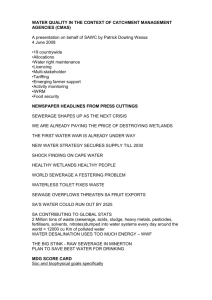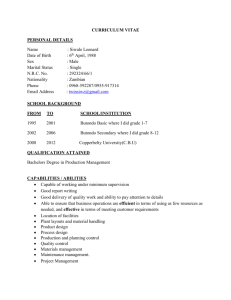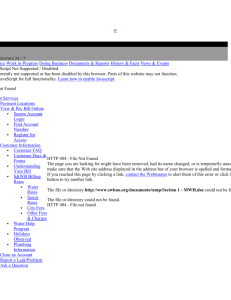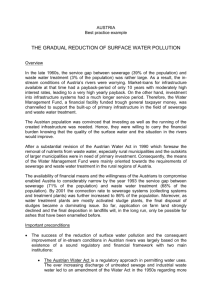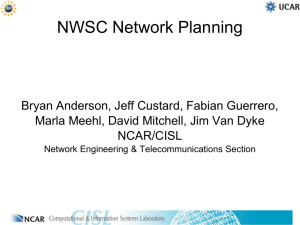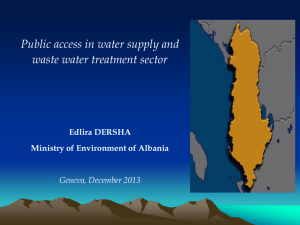William Tsimwa Muhairwe, The Case of National Water and
advertisement
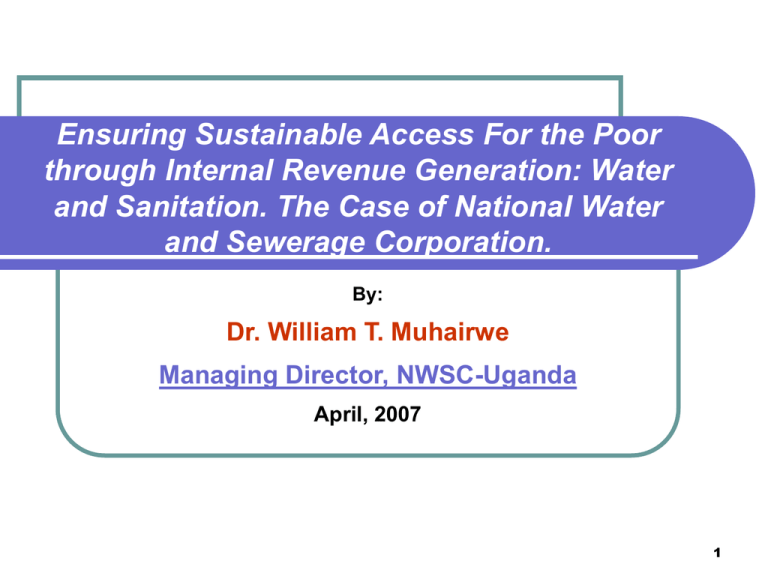
Ensuring Sustainable Access For the Poor through Internal Revenue Generation: Water and Sanitation. The Case of National Water and Sewerage Corporation. By: Dr. William T. Muhairwe Managing Director, NWSC-Uganda April, 2007 1 Introduction Internal Revenue Optimization: Definition • Internal Revenues synonymous with Operating Margins: • Defined as the difference between • Operating Revenues • Operating Costs • Need to optimize Revenues • Contain Costs • Thereby realize investible funds 2 Operational Efficiency; (The Old NWSC as at 1998) High number of unviable towns ( only 3 out of 12) High arrears level of 14 months old Very expensive labour force (1800No => 36 staff/1000c) Low operational efficiency with high NRW of 50-60% Irrational and costly welfare scheme Poor organizational public sector behavior e.g. late coming, corruption etc Lack of performance incentives for Area Managers and Staff Rampant water leakages and sewage spillages Low collection efficiency of 60% Intermittent service in several towns ranging from 15-21 hrs A running monthly deficit of about Ushs 348M (~US$ 300,000) despite a high average tariff of Ush 1100/m3 (US$ 1.00/m3) The high debt burden ($100 million) 3 NWSC Cost Recovery Interventions Policy level Strategic level, Change in Board Operational level Operational framework through change management programmes:100 Days, Service and Revenue Enhancement Programme (SEREP), Area Performance Contracts (APC’s), Internally Delegated Area Management Contracts (IDAMC’s), One Minute Management Concept (OMM), CHECKERS system Organizational behavior Customer care Cost reduction Technical and commercial performance Incentive mechanisms See our Website for details: www.nwsc.co.ug 4 NWSC Cost Recovery Interventions Optimisation of Revenue: Restored Customer Confidence Establishment of Customer care centres Improvement in office ambience Training in Customer care Conducting of Customer surveys Amnesty for illegal water use Revenue squads/Territorial Management Concept Increasing market size through increasing Connections (Economies of Scale) 5 NWSC Cost Recovery Interventions Cost Containment Staff Rightsizing : from 1,850 in 1999 to 850 in 2001, (2006, 1200) Reduction in administration and overhead costs No Labour Unrest Vehicle maintenance Medical Travel Illicit activities Strict Appraisal of Capital projects Reduction in operating inefficiencies (UFW, Staff Productivity, Working ratios etc) 6 NWSC Cost Recovery Interventions Tariffs: Simplification/Rationalisation and Indexation Tariff last revised in 1994.(To approx US $ 1/Cu.m) Indexation of the Tariff 2000 (Aver. Appr. US $ 50cts) Reduction in connection fees by 50% Reduction in Reconnection fees by 75% Elimination of Minimum charge Introduction of a service charge (minimal) Free Water and Sewerage Connection Policy 7 Financing of Service to the Poor Constructed more than 1,370 km of new water mains Construction of Stand posts Average of 300 per annum Preference to Yard taps due to Short Falls of Stand posts Subsidised New Connections Serve peri-urban areas Serve poor Water 50 meters radius Sewerage 60 meters radius. Operation of a Cross subsidy: Across Customer groups Across Areas by application of Uniform Tariff 8 Allocating State Revenues to Utilities Within Context of =>Performance Contract (to ensure continuous performance improvements) =>Poverty Eradication Action Plan (PEAP) => Sector Wide Approach To Planning Government to Finance Upfront big Infrastructure Investments (Water Works & Sewerage systems, big transmission mains etc) Social mission activities including service to the poor. Take over of non viable towns -pre-finance Agreed Debt write off to enable ploughing back of revenues for investment especially to the poor 9 Operating Efficiency Gains (The New NWSC) (According to 2005/06 Audited Accounts) Service coverage increased from 48% to 70% Total Connections increased from 50,826 to 152,046 in 2006 Metered Connections from 37,217 to 149,963 New connections per year from 3,317 to about 28,521 p.a. Staff per 1,000 connections reduced from 36 to 7 in 2006 UfW reduced from 51% in 1998 to 29.3% in 2006 Kampala from 55% to 35.1% Other Areas from 43% to 15.2% Collection Efficiency increased from 60% in 1998 to 95% in 2006 Increase in operating profit (1998-2006) Before dep from UShs 1.5 bn ($800,000) to UShs 14 bn ($ 8 m) After dep. from minus UShs 0.75 bn ($400,000) to US Shs 4.3 bn ($ 2.5 m) Annual turnover increased from Ushs 21 bn (US $ 12 m) to Ushs 58 bn (U S $ 33 m) in 2006 10 Sharing Experiences and Benchmarking External Services a Response for need to replicate NWSC’s experiences and innovations to other utilities and institutions within and outside Africa. Services Offered: Advisory Services, e.g. Organizational behavior change, Contract design and incentive systems Core Utility Services e.g. Commercial & Customer Care/IT Services, Static Plant Maintenance Who have benefited from our Services? The Water Sector Nairobi Water and Sewerage Company, Lake Victoria Water services Board,Athi River Water Services Board, NZOWASCO Ltd: Kenya, Nkana Water, (Lusaka Water and Sewerage Co??): Zambia DAWASA/DAWASCO: Dar-es-salaam: Tanzania Ghana Water Company: Ghana?? Karachi Water and Sewerage Co.: Pakistan New Delhi Water Board and Several Water Municipality Water Boards in India Outside the Water Sector Steel Rolling Mills Alam Group of Co., Sembule Steel Mills, The Lands Dept in Ministry of Lands and Housing The Kampala City Council?? 11 In Conclusion • Need for a multi pronged approach to finance the poor • Improved operational efficiency a prerequisite for improved financial performance. • Tariff restructuring a necessity as a short term intervention. • However full cost recovery in the short and medium term may be a myth especially in LDCs • Long term sustainability of service to the poor and big infrastructure projects can only be financed by targeted subsidies by the state or through ODA. • However Utilities urged not to be complacent about internal financing of investments. 12
